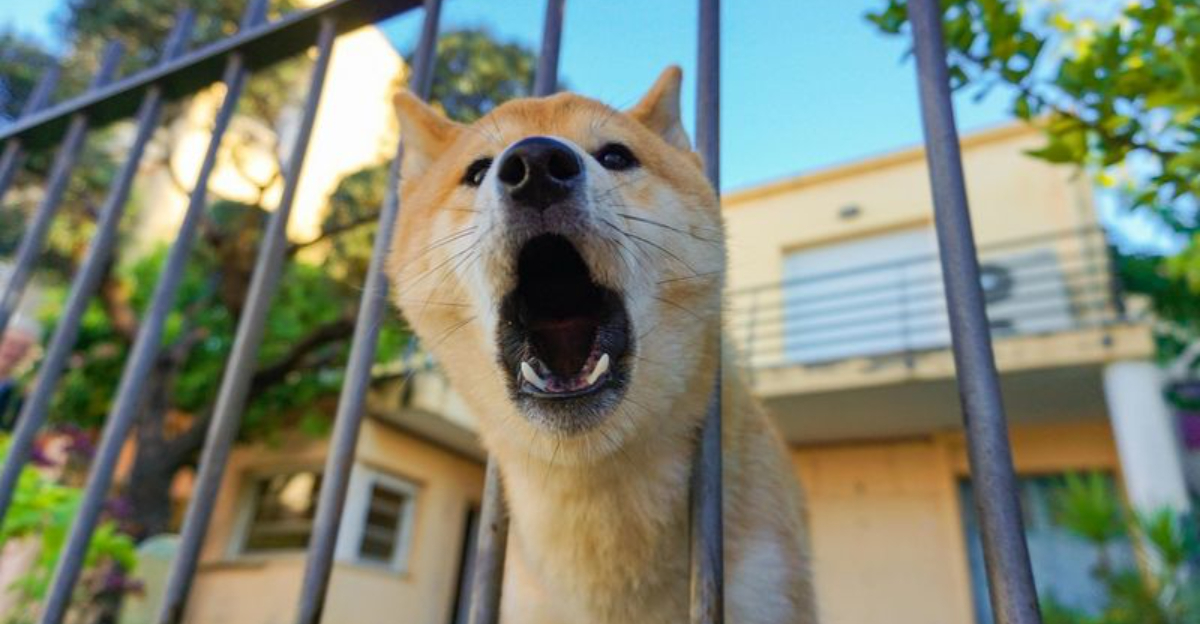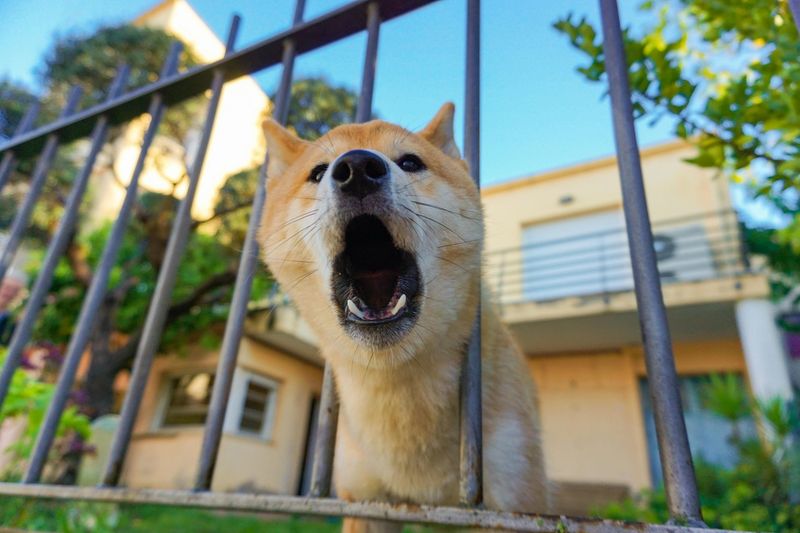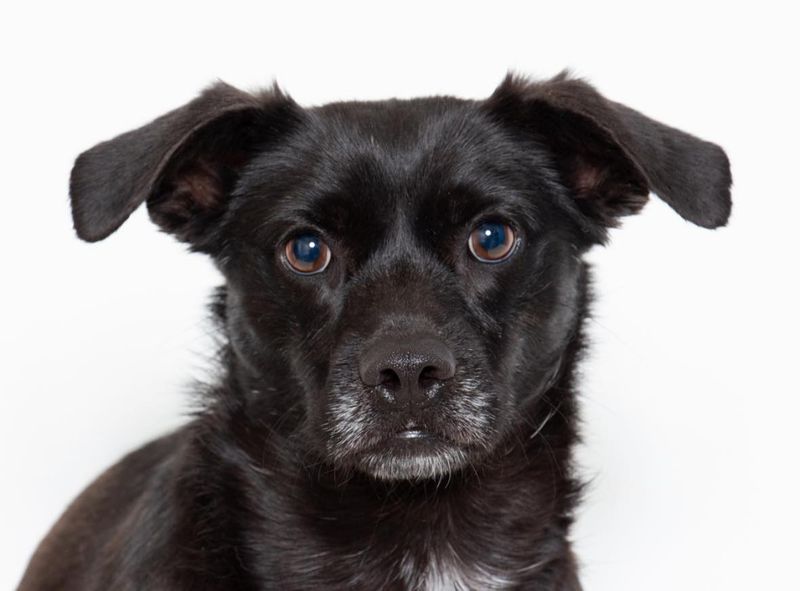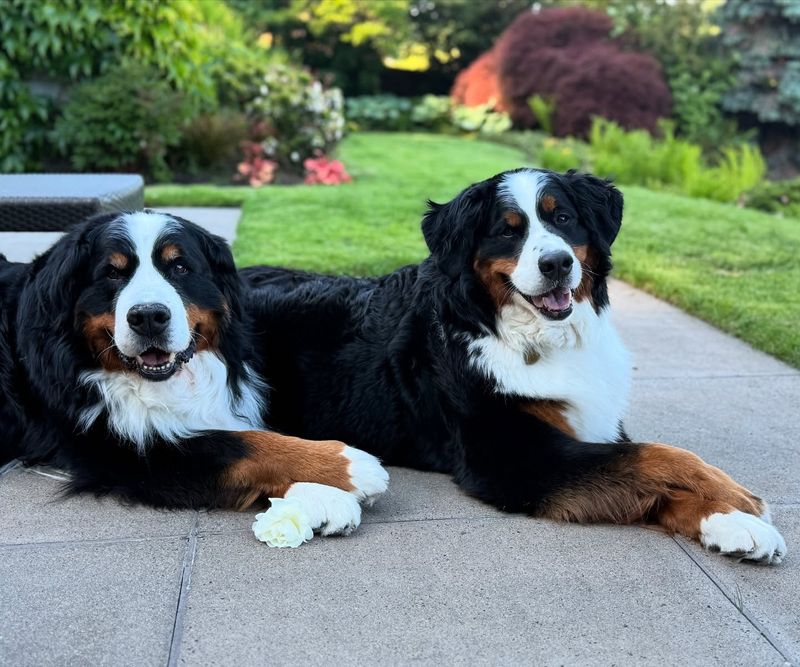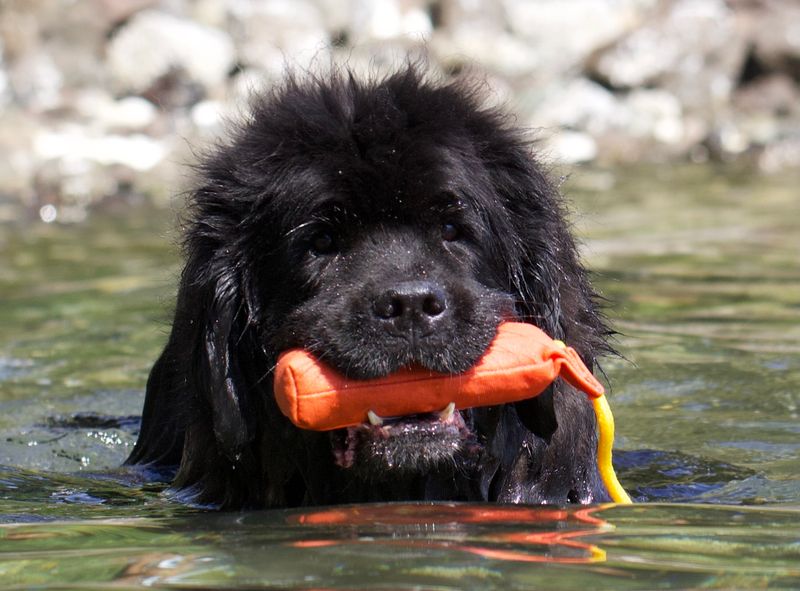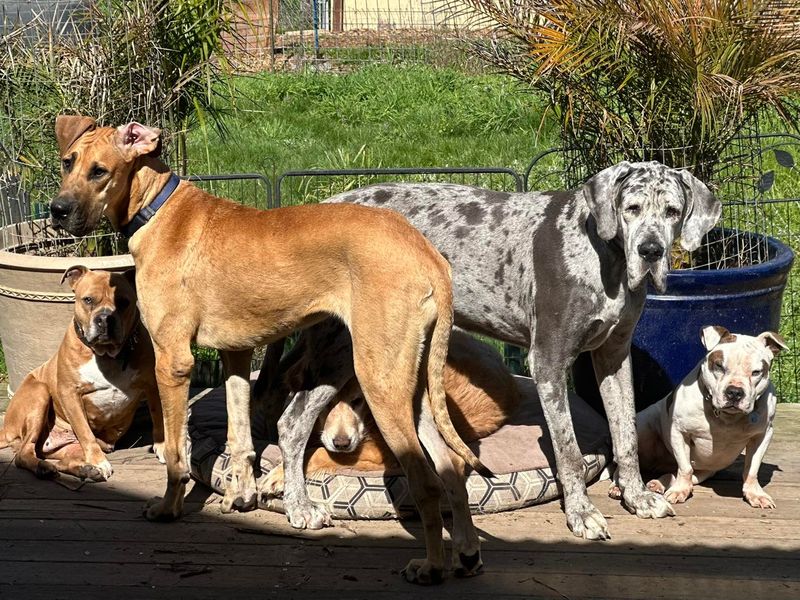In this comprehensive blog post, we explore the intriguing world of canine communication. Dogs, much like humans, have unique ways to express their displeasure and emotions. While some breeds are notorious for their expressive nature, others are known for their calm demeanor. Through this guide, discover twelve distinct ways dogs show displeasure, as well as twelve breeds that are famously serene. Whether you’re a seasoned dog owner or just curious about canine behavior, this post offers valuable insights into the diverse personalities of dogs.
Growling
A dog’s growl can send shivers down one’s spine, but it’s not always a sign of aggression. Sometimes, it’s just their way of saying, “I’m uncomfortable.” Dogs growl to express dissatisfaction, signaling discomfort or stress. It’s crucial to recognize this early to prevent escalation.
Observing a dog’s body language when growling can aid in understanding their feelings. Relaxed posture indicates mild annoyance, while tense muscles may suggest a deeper issue. Understanding these subtleties fosters a harmonious relationship.
Recognizing this vocalization helps in addressing the root cause, ensuring both safety and comfort.
Whining
Whining is often mistaken for misbehavior, but it’s one of the most common ways dogs express discomfort. When a dog whines, it’s like a toddler asking for attention or expressing needs.
This vocalization can mean many things: hunger, loneliness, or the need to go outside. Each context requires different responses. Attending to these cries not only comforts your pet but also strengthens your bond.
By understanding the nuances of whining, you’re better equipped to meet your dog’s needs, providing them with a sense of security and love.
Avoidance Behaviors
Avoidance behaviors in dogs are subtle yet telling signs of displeasure. Often overlooked, these actions speak volumes about their emotional state.
A dog may turn its head, avoid eye contact, or move away, indicating discomfort or unease. Such behaviors suggest that the dog prefers space and quiet over interaction at that moment.
Respecting these signals is key to fostering trust. By giving them space, you acknowledge their feelings, leading to a healthier relationship. Observing these cues ensures your dog’s comfort and well-being.
Barking
Barking is a multifaceted form of communication in dogs. Often perceived as a nuisance, it can indicate displeasure or alertness.
Dogs bark to express frustration or discomfort, such as when they’re left alone too long or when strangers approach. Each bark varies in tone and intensity, signaling different emotions.
Understanding your dog’s specific bark patterns helps in addressing their concerns. Whether it’s a call for attention or a warning, acknowledging these vocal cues strengthens trust and communication.
Pacing
Pacing in dogs is akin to nervous foot-tapping in humans. It’s a physical manifestation of anxiety or restlessness. When a dog paces, it’s often trying to calm itself or express unease.
This behavior is common when routines are disrupted or when they’re anticipating something stressful. It’s crucial to identify the cause and provide reassurance.
Intervening when a dog paces can prevent further anxiety, ensuring comfort. By understanding this behavior, you can address the root cause, helping your pet feel secure and loved.
Ears Back
When a dog’s ears are pinned back, it often signals discomfort or fear. This subtle gesture is a window into their emotional state.
Dogs use ear positions to communicate, and recognizing this can prevent misunderstandings. Ears back may indicate they feel threatened or anxious.
Acknowledging this sign allows for a quick intervention, ensuring your dog’s comfort. Observing their ear language fosters a deeper connection, allowing for better care and understanding.
Licking Lips
Lip licking is a subtle but powerful way dogs convey discomfort. It’s often misunderstood, but it’s their way of saying, “I’m uneasy.”
This behavior usually accompanies other signs of stress, such as yawning or turning away. It’s crucial to observe these in context to accurately interpret their feelings.
By recognizing lip licking as a stress signal, owners can intervene and provide comfort. This understanding ensures a supportive environment, helping your dog feel safe and secure.
Tail Tucking
A tucked tail is one of the clearest signals of fear or submission in dogs. It’s their way of making themselves smaller and less noticeable.
This behavior often occurs in new or intimidating environments. Understanding the context is key to addressing their fear. Offering reassurance and gentle encouragement can ease their discomfort.
By recognizing this sign, you can provide a comforting presence, helping your dog feel more at ease. Observing body language like tail tucking ensures a deeper understanding of your pet’s emotional state.
Yawning
Yawning in dogs is more than just a sign of tiredness; it’s a subtle way they communicate stress. Observing when and why a dog yawns can reveal much about their emotional state.
This behavior often occurs in tense situations, acting as a calming signal. Recognizing it can help prevent stress escalation.
By acknowledging yawning as a sign of unease, you can provide comfort and reassurance. This awareness strengthens the bond between you and your pet, ensuring they feel understood and cared for.
Freezing
Freezing is a telling behavior that many dogs display when they’re unsure or frightened. It’s akin to the human response of pausing when startled.
When a dog freezes, it’s crucial to assess the environment for potential stressors. This behavior signals that the dog needs time to assess the situation.
By understanding freezing as a stress response, you can provide necessary support. Helping your dog navigate these moments ensures they feel safe and secure. This awareness fosters a trusting relationship.
Refusing Treats
Refusing treats is an uncommon but significant sign of displeasure or illness in dogs. When a typically food-motivated dog declines a treat, it’s worth investigating further.
This behavior can indicate stress, discomfort, or health issues. Observing the context and accompanying behaviors helps in understanding the underlying cause.
By recognizing treat refusal as a potential red flag, you can address any issues promptly. This proactive approach ensures your dog’s well-being and happiness.
Hiding
Hiding is a natural behavior for dogs seeking comfort or escape from stress. It’s their way of retreating from overwhelming situations.
This action can signal fear or a need for solitude. Understanding the reasons behind hiding helps in providing appropriate support.
Acknowledging this behavior as a sign of stress allows for timely intervention. Offering a safe space and gentle reassurance can help your dog feel more secure.
Cavalier King Charles Spaniel
The Cavalier King Charles Spaniel is often described as an embodiment of grace and tranquility. With their large, expressive eyes and gentle demeanor, they rarely show any sign of complaint.
These dogs are known for their easygoing nature, making them ideal companions for families and singles alike. Their adaptability to various living situations, from apartments to large homes, contributes to their reputation for being low-maintenance.
This breed’s calm disposition, combined with their affectionate nature, ensures they remain a favorite among dog lovers seeking a serene companion.
Basset Hound
With their droopy eyes and long ears, Basset Hounds exude a sense of calm and patience. These dogs are known for their laid-back attitude, rarely showing signs of displeasure.
Their gentle nature makes them fantastic companions for those seeking a relaxed pet. Basset Hounds are content with leisurely walks and plenty of nap time, forming strong bonds with their families.
Their unique appearance, combined with their affectionate nature, makes them a delightful addition to any household, providing unconditional love with minimal fuss.
Shih Tzu
The Shih Tzu, with its luxurious coat and regal demeanor, is known for its calm disposition. These small dogs carry an air of serenity, often content to lounge and observe the world around them.
Their friendly nature and adaptability make them great companions for all ages. Shih Tzus are often described as “lap dogs,” enjoying quiet moments with their owners.
Despite their royal appearance, they are low-maintenance and rarely complain, making them a perfect choice for those seeking a peaceful and loving pet.
Bernese Mountain Dog
With a heart as big as its paws, the Bernese Mountain Dog is a gentle giant that seldom complains. Known for their affectionate nature, these dogs are incredibly loyal and patient.
Their gentle demeanor makes them excellent family dogs, often forming strong bonds with children and adults alike. Bernese Mountain Dogs thrive in environments where they can enjoy the outdoors and be part of family activities.
Their calm and composed nature ensures they remain a beloved choice for those seeking a devoted and serene companion.
Whippet
The Whippet is often described as a “couch potato” with bursts of energy. Known for their sleek appearance, these dogs enjoy long naps and short sprints.
Their calm and gentle temperament makes them ideal pets for various households. Whippets are affectionate and content with minimal exercise, often enjoying the simple pleasures of life.
This breed’s easygoing nature, combined with their affectionate disposition, ensures they remain a popular choice for those seeking a relaxed yet playful companion.
French Bulldog
French Bulldogs are known for their charming personalities and relaxed demeanor. These compact dogs are often content with lounging and watching the world go by.
Their friendly and adaptable nature makes them perfect for city living. French Bulldogs form strong bonds with their owners, providing affectionate companionship with minimal demands.
Their unique appearance and easygoing personality make them a delightful addition to any home, offering love and laughter with little fuss.
Newfoundland
Known for their gentle and protective nature, Newfoundlands are often referred to as “gentle giants.” Their calm demeanor and sweet disposition make them excellent family dogs.
These dogs are famously patient, often forming strong bonds with children. Newfoundlands thrive in environments where they can swim and participate in family activities.
Their affectionate nature and serene presence ensure they remain a beloved choice for those seeking a loving and devoted companion.
Great Dane
Despite their imposing stature, Great Danes are known for their gentle and affectionate nature. These giants are often described as “gentle giants,” content with lounging and enjoying quiet moments.
Their calm demeanor makes them excellent companions for those seeking a relaxed pet. Great Danes form strong bonds with their families, offering love and protection.
Their majestic appearance, combined with their sweet nature, ensures they remain a popular choice for those seeking a loyal and loving companion.
Bulldog
Bulldogs are known for their calm and laid-back attitude, making them fantastic companions for those seeking a relaxed pet. Their affectionate nature and easygoing demeanor ensure they rarely show displeasure.
These dogs are content with short walks and plenty of nap time, enjoying the company of their families. Bulldogs form strong bonds with their owners, providing unconditional love with minimal demands.
Their unique appearance and gentle personality make them a delightful addition to any household, offering love and companionship with little fuss.
Greyhound
The Greyhound, often described as a “50-mile-per-hour couch potato,” is known for its calm and gentle nature. Despite their racing background, these dogs are content with lounging and enjoying quiet moments.
Their affectionate and laid-back demeanor makes them excellent companions for various households. Greyhounds form strong bonds with their families, seeking love and attention without being demanding.
Their sleek appearance and easygoing personality ensure they remain a beloved choice for those seeking a relaxed yet affectionate companion.
Irish Wolfhound
With a heart as vast as its size, the Irish Wolfhound is a gentle giant known for its serene nature. These dogs are often described as calm and affectionate, forming strong bonds with their families.
Their gentle demeanor makes them excellent companions for those seeking a relaxed pet. Irish Wolfhounds enjoy leisurely walks and quiet moments, providing unconditional love and companionship.
Their impressive stature, combined with their sweet nature, ensures they remain a popular choice for those seeking a loyal and loving companion.
Subtle Stiffening
Ever noticed your dog’s body becoming slightly rigid during a walk or playtime? This subtle stiffening can be a dog’s quiet way of expressing displeasure. Unlike overt signals, this behavior may go unnoticed by many. It’s like a whisper in a bustling room: easily missed but significant.
Dogs may stiffen their bodies when they’re uncomfortable with a situation, perhaps when meeting an unfamiliar dog or encountering a new environment. Observing this can help owners gauge their pet’s comfort.
Being attuned to such mild signals allows you to address your dog’s concerns before they escalate, ensuring a happier pet.
